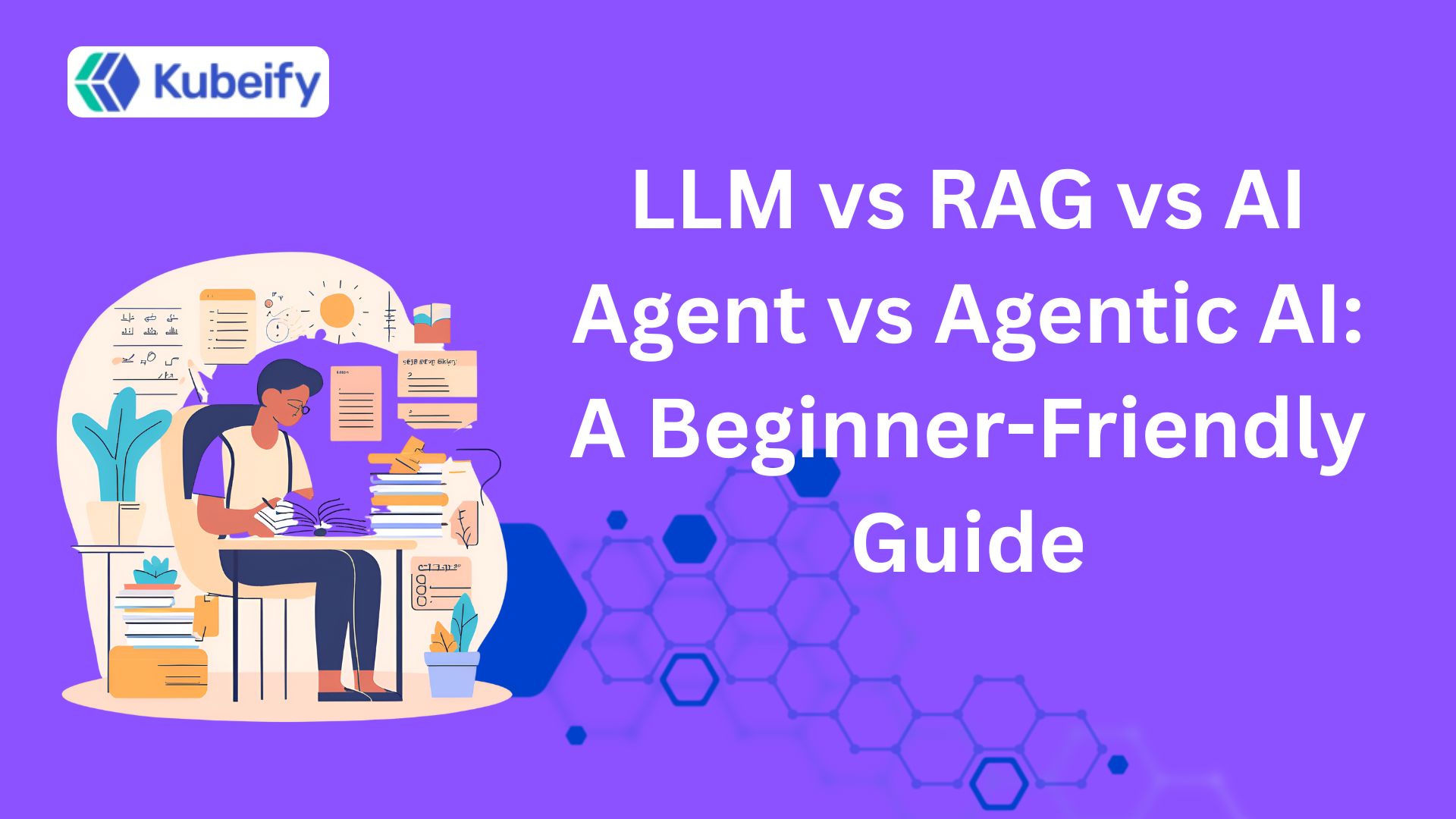AI Cloud
- Cloud Native Product Development
- Cloud Native FaaS
- Monolith to Microservices
- DevSecOps as a Service
- Kubernetes Zero Downtime

Understanding the world of LLMs, RAG, AI Agents, and Agentic AI is essential for today’s developers, whether you’re just starting out or looking to solidify your grasp on modern AI architectures. Let’s break down each term, compare them, and show how they fit together in practical applications—and how you can learn to master them!
LLMs (Large Language Models), like GPT-4 or Llama 3, are powerful AI models trained on vast datasets to generate human-like text, answer questions, and even write code. They excel at understanding and producing language, but they have some major limitations:
Example: ChatGPT answers a question about history, but may give outdated info if the event happened after its training period.
RAG is a way to supercharge LLMs by connecting them to external sources of information, such as databases or the internet. Instead of relying only on their (static) training data, RAG-powered models:
Why is RAG important?
Example: A RAG-powered chatbot can answer questions about your company’s documentation—even if the LLM was never trained on it.
Think of AI Agents as autonomous digital assistants powered by AI. Unlike traditional AI that takes an instruction and returns an answer, AI Agents can:
This approach enables automation far beyond simple Q&A.
Example: An agent can plan a trip for you. It will look up flights, compare options, book a ticket, and even send you emails—deciding how to do each step along the way.
Agentic AI is the next evolutionary step. Here, LLMs, RAG, and AI Agents are merged so the system is proactive and “agentic” (meaning it takes initiative to achieve goals):
Example: An agentic AI could monitor stock prices in real time, decide when to retrieve the newest data, analyze trends, generate a human-readable report, and automatically email it to stakeholders.
| Concept | Main Ability | Limitation | Use Case Example |
|---|---|---|---|
| LLM | Language generation | Frozen knowledge, hallucination | Chatbots, code assist |
| RAG | Fact-grounded responses | Limited decision-making | Company search bot |
| AI Agent | Task automation, decision-making | May lack real-time info | Travel booking, workflow automation |
| Agentic AI | Proactive, multi-step, adaptive | Complexity, higher resource use | Automated research, complex business ops |
LLMs, RAG, AI Agents, and Agentic AI represent a spectrum of AI capability: from language generation to factually grounded Q&A, to independent digital agents, to fully autonomous, adaptive problem-solvers. Each layer builds on the one before, and learning to orchestrate them gives developers the power to build the next generation of intelligent applications.
Start simple, build projects, experiment with RAG and agentic principles, and you’ll progress quickly from curiosity to practical mastery!
Further Learning:
Q1: What’s the difference between an LLM and RAG?
A: An LLM is a language model that can generate content but only knows what it was trained on. RAG adds real-time or custom information, reducing hallucinations and improving accuracy.
Q2: Can RAG prevent all hallucinations in LLM outputs?
A: RAG significantly reduces hallucinations by grounding answers in real data, but some errors can still slip through if the retrieval step fetches irrelevant or wrong info.
Q3: Is an AI Agent just a chatbot?
A: No. AI Agents can take goal-oriented actions (like booking, searching, summarizing), not just answer questions. They can call tools, trigger workflows, and manage multi-step processes.
Q4: What makes Agentic AI different from basic AI agents?
A: Agentic AI takes initiative: it plans, iteratively gathers information, adapts, decides when to call APIs or search, and can handle ambiguous, complex, or multi-step goals without constant human guidance.
Q5: How can a beginner start experimenting with these concepts?
A: Begin with basic LLM APIs, learn LangChain for RAG, then try agent frameworks like CrewAI. Online tutorials and open-source projects are great entry points.
Q6: Do I need advanced math or deep learning experience to build with AI agents?
A: Not at first! Many tools/libraries abstract away the deep tech—basic Python, API usage, and understanding prompt engineering are enough to get started.
Q7: What are the most popular frameworks for Agentic AI?
A: LangChain, CrewAI, AgentGPT, and Superagent.ai are popular frameworks for building AI agents and agentic systems.
Q8: Are these tools production-ready or best for experiments?
A: Many are still maturing, but some (like LangChain) are being used in real-world products. Always review documentation and stability before deploying mission-critical solutions.
Q9: Where can I see examples or demos?
A: Check GitHub repos of LangChain or CrewAI, and YouTube tutorials for practical walkthroughs.
Q10: How fast is this field changing?
A: Extremely fast! Join forums, follow dev blogs, and stay updated—the best practices and tools evolve every month.

Kubeify's team decrease the time it takes to adopt open source technology while enabling consistent application environments across deployments... letting our developers focus on application code while improving speed and quality of our releases.
– Yaron Oren, Founder Maverick.ai (acquired by OutboundWorks)
Let us know what you are working on?
We would help you to build a
fault tolerant, secure and scalable system over kubernetes.
